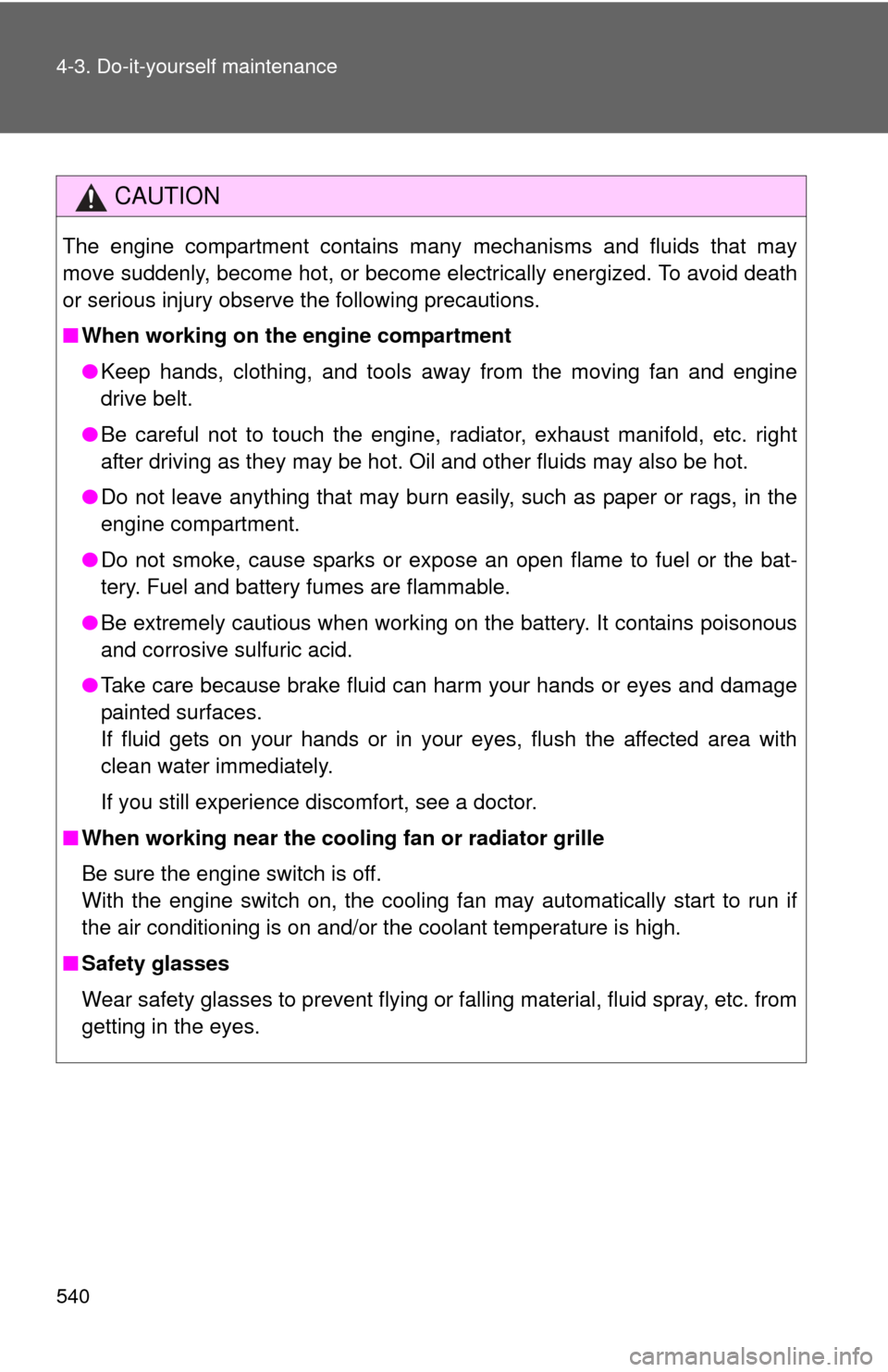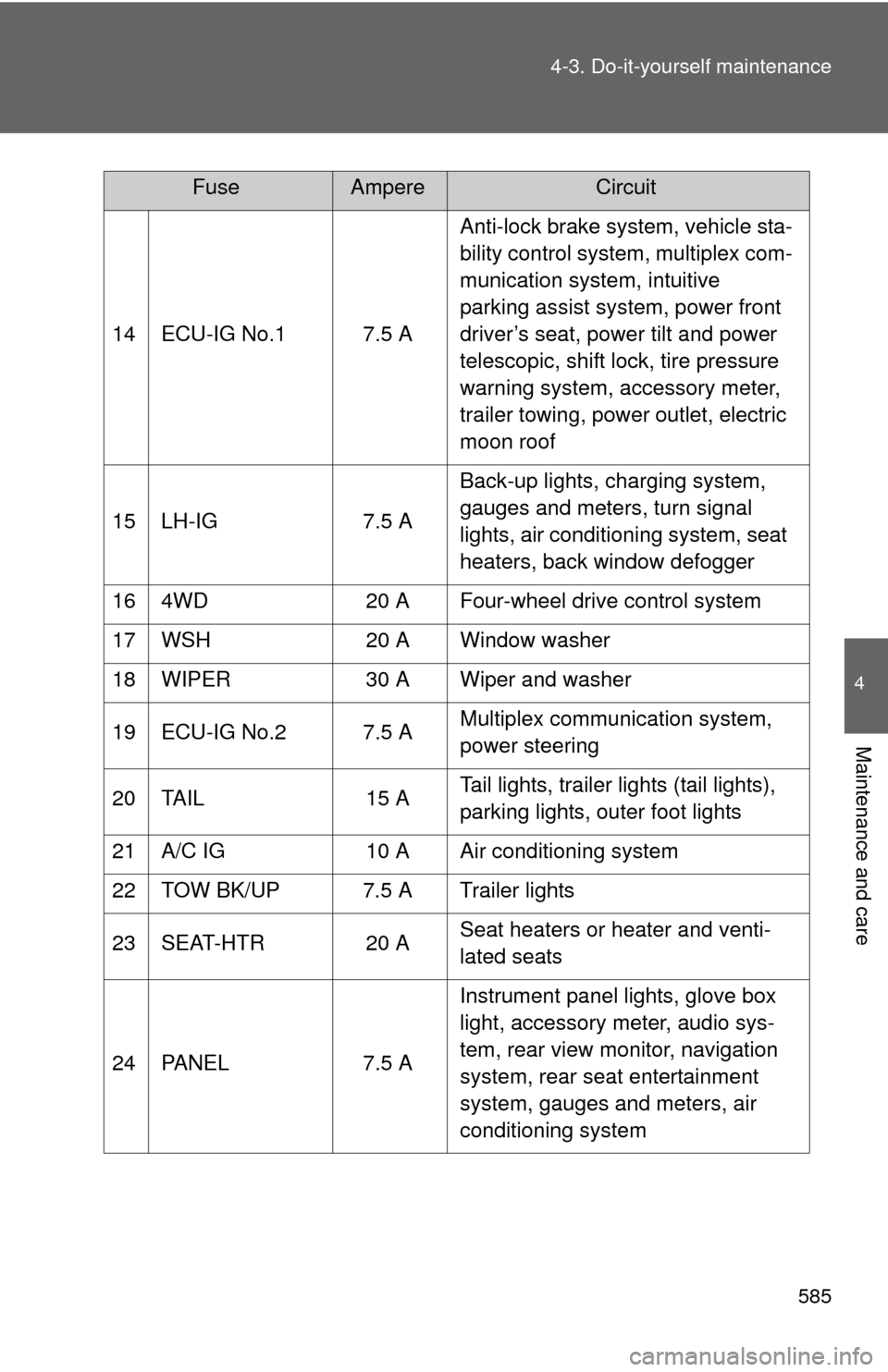Page 525 of 744
Maintenance and care4
525
4-1. Maintenance and careCleaning and protecting the vehicle exterior ......... 526
Cleaning and protecting the vehicle interior .......... 529
4-2. Maintenance Maintenance requirements .................. 532
General maintenance....... 534
Emission inspection and maintenance (I/M)
programs........................ 537
4-3. Do-it-yourself maintenance Do-it-yourself service precautions .................... 538
Hood ................................ 542
Engine compartment ........ 543
Tires ................................. 557
Tire inflation pressure ...... 565
Wheels ............................. 569
Air conditioning filter......... 572
Wireless remote control battery ............................ 575
Checking and replacing fuses .............................. 577
Light bulbs........................ 588
Page 540 of 744

540 4-3. Do-it-yourself maintenance
CAUTION
The engine compartment contains many mechanisms and fluids that may
move suddenly, become hot, or become electrically energized. To avoid death
or serious injury observe the following precautions.
■When working on the engine compartment
●Keep hands, clothing, and tools away from the moving fan and engine
drive belt.
● Be careful not to touch the engine, radiator, exhaust manifold, etc. right
after driving as they may be hot. Oil and other fluids may also be hot.
● Do not leave anything that may burn easily, such as paper or rags, in the
engine compartment.
● Do not smoke, cause sparks or expose an open flame to fuel or the bat-
tery. Fuel and battery fumes are flammable.
● Be extremely cautious when working on the battery. It contains poisonous
and corrosive sulfuric acid.
● Take care because brake fluid can harm your hands or eyes and damage
painted surfaces.
If fluid gets on your hands or in your eyes, flush the affected area with
clean water immediately.
If you still experience discomfort, see a doctor.
■ When working near the cooling fan or radiator grille
Be sure the engine switch is off.
With the engine switch on, the cooling fan may automatically start to run if
the air conditioning is on and/or the coolant temperature is high.
■ Safety glasses
Wear safety glasses to prevent flying or falling material, fluid spray, etc. from
getting in the eyes.
Page 572 of 744
572
4-3. Do-it-yourself maintenance
Air conditioning filter
The air conditioning filter must be cleaned or changed regularly to
maintain air conditioning efficiency.
■ Removal method
Turn the engine switch off.
Open the glove box.
Remove the tray.
Remove the cover by sliding
up while pulling toward you.
Page 574 of 744
574 4-3. Do-it-yourself maintenance
■Checking interval
Inspect, clean and replace the air conditioning filter according to the mainte-
nance schedule. In dusty areas or areas with heavy traffic flow, more fre-
quent cleaning or early replacement may be required. (For scheduled
maintenance information, please refer to the “Scheduled Maintenance
Guide” or “Owner’s Manual Supplement”.)
■ If air flow from the vents decreases dramatically
The filter may be clogged. Check the filter and replace if necessary.
NOTICE
■To prevent damage to the system
●When using the air conditioning system, make sure that a filter is always
installed.
● When cleaning the filter, do not clean the filter with water.
■ Replacement method
Remove the air conditioning
filter and replace it with a new
one.
The“ UP” marks shown on the
filter should be pointing up.
Page 583 of 744
583
4-3. Do-it-yourself maintenance
4
Maintenance and care
*: Replace the fuse with one of the same ampere rating as the original.
37 DEFOG 40 A Back window defogger
38 SUB BATT 40 A Trailer towing
39 ABS1 50 A
Anti-lock brake system, vehicle sta-
bility control system
40 ABS2 40 A Anti-lock brake system, vehicle sta-
bility control system
41 ST 30 A Starting system
42 HTR 50 A Air conditioning system
43 LH-J/B 150 A AM1, TAIL, PANEL, ACC, CIG, LH-
IG, 4WD, ECU-IG No.1, BK/UP LP,
SEAT-HTR, A/C IG, ECU-IG No.2,
WSH, WIPER, OBD, A/C, TI&TE,
FR P/SEAT RH, MIR, DR/LCK, FR
P/SEAT LH, CARGO LP, PWR
OUTLET, POWER No.1 fuses
44 ALT 180 A
*LH-J/B, HTR, SUB BATT, TOW
BRK, STOP, FOG, TOW TAIL,
DEICER fuses
140 A
*
45 A/PUMP NO.1 50 A Multiport fuel injection system/
sequential multiport fuel injection
system
46 A/PUMP NO.2 50 A Multiport fuel injection system/
sequential multiport fuel injection
system
47 MAIN 40 A HEAD LL, HEAD RL,
HEAD LH, HEAD RH fuses
FuseAmpereCircuit
Page 584 of 744
584 4-3. Do-it-yourself maintenance
■Under the instrument panel
FuseAmpereCircuit
1 INVERTER 15 A Power outlet (115V)
2 FR P/SEAT LH 30 A Power front driver’s seat
3 DR/LCK 25 A Multiplex communication system
4 OBD 7.5 A On-board diagnosis system
5 PWR OUTLET 15 A Power outlets
6 CARGO LP 7.5 A Cargo lamp
7 AM1 7.5 A Shift lock system, starting system
8 A/C 7.5 A Air conditioning system
9 MIR 15 A Outside rear view mirror control,
outside rear view mirror heaters
10 POWER No.3 20 A Power windows
11 FR P/SEAT RH 30 A Power front passenger seat
12 TI&TE 15 A Power tilt and power telescopic
13 S/ROOF 25 A Electric moon roof
Page 585 of 744

585
4-3. Do-it-yourself maintenance
4
Maintenance and care
14 ECU-IG No.1 7.5 A
Anti-lock brake system, vehicle sta-
bility control system, multiplex com-
munication system, intuitive
parking assist system, power front
driver’s seat, power tilt and power
telescopic, shift lock, tire pressure
warning system, accessory meter,
trailer towing, power outlet, electric
moon roof
15 LH-IG 7.5 A Back-up lights, charging system,
gauges and meters, turn signal
lights, air conditioning system, seat
heaters, back window defogger
16 4WD 20 A Four-wheel drive control system
17 WSH 20 A Window washer
18 WIPER 30 A Wiper and washer
19 ECU-IG No.2 7.5 A Multiplex communication system,
power steering
20 TAIL 15 A Tail lights, trailer lights (tail lights),
parking lights, outer foot lights
21 A/C IG 10 A Air conditioning system
22 TOW BK/UP 7.5 A Trailer lights
23 SEAT-HTR 20 A Seat heaters or heater and venti-
lated seats
24 PANEL 7.5 A Instrument panel lights, glove box
light, accessory meter, audio sys-
tem, rear view monitor, navigation
system, rear seat entertainment
system, gauges and meters, air
conditioning system
FuseAmpereCircuit
Page 652 of 744
652 5-2. Steps to take in an emergency
The engine has cooled down sufficiently.
The engine coolant temperature gauge indicates C.
Check the engine coolant level.
Look for obvious coolant leaks from the radiator, hoses and
under the vehicle.
Note that water draining from the air conditioning is normal if it has
been used.
Add engine coolant if required.
Water can be used in an emer-
gency if engine coolant is
unavailable. ( P. 673)
Have the vehicle checked at your nearest Toyota dealer as soon as
possible.